What Is the Best Soil for a Philodendron Cordatum?
The best soil for Philodendron Cordatum is a well-draining blend made up of peat moss, perlite, and orchid bark. This blend guarantees moisture retention, aeration, and structural stability, promoting strong root development and nutrient uptake.
Maintaining the pH level between 5.5 and 6.5 is essential to prevent nutrient lockout and support peak growth. Make sure the soil mix includes organic materials like compost, which boost microbial activity and soil fertility.
Regular soil testing and adjustments with sulfur or lime will help maintain ideal nutrient levels. For more insights on soil maintenance and DIY recipes, continue further.
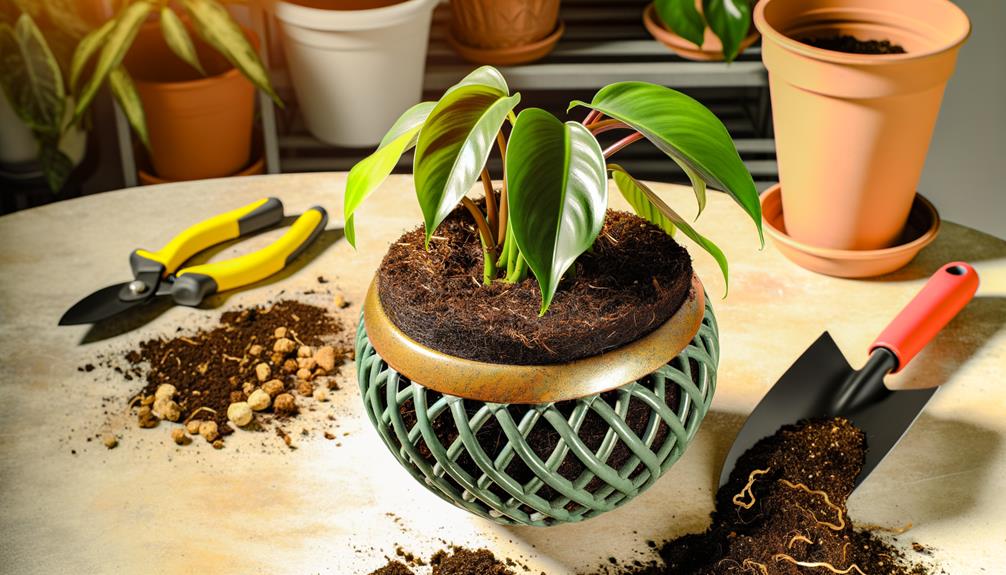
Key Takeaways
- A mix of peat moss, perlite, and orchid bark ensures proper moisture retention and aeration.
- Maintain soil pH between 5.5 and 6.5 for optimal nutrient absorption.
- Use well-draining materials like perlite and pumice to prevent root rot.
- Incorporate organic matter such as compost or worm castings to enhance soil fertility.
- Regularly monitor soil moisture and pH to maintain ideal growing conditions.
Importance of Soil Composition
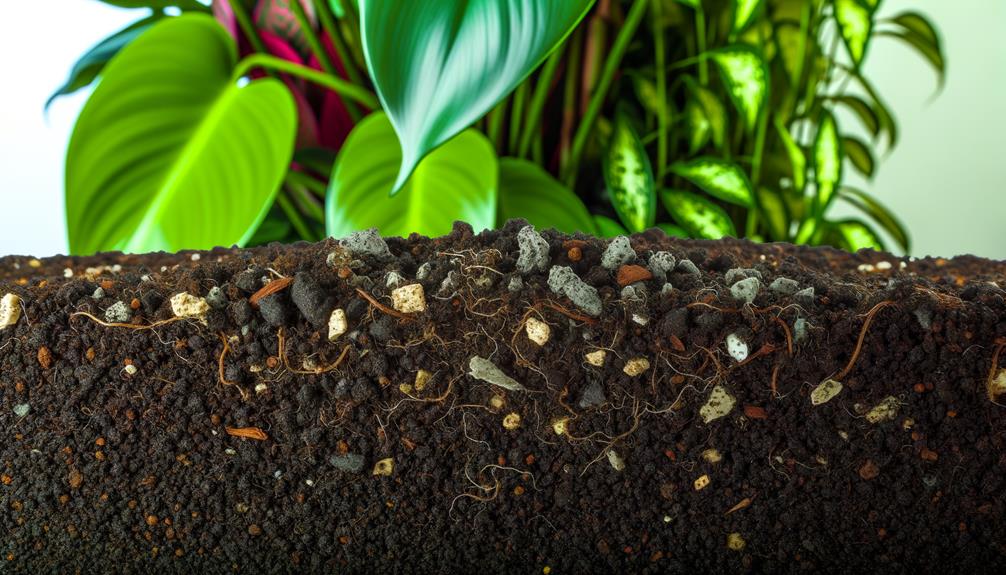
Understanding the importance of soil composition is crucial for optimizing the growth and health of a Philodendron Cordatum.
A well-balanced soil mix should include components such as peat moss, perlite, and orchid bark, each contributing specific properties. Peat moss retains moisture while ensuring adequate aeration, perlite enhances drainage and prevents soil compaction, and orchid bark provides structural stability.
The synergy of these elements creates a medium that promotes robust root development and nutrient uptake. Ensuring proper organic matter content also supports microbial activity, which is essential for nutrient cycling.
Ideal Ph Levels
Maintaining an ideal pH level between 5.5 and 6.5 is important for the best growth of a Philodendron Cordatum, as it secures the availability of essential nutrients and prevents potential nutrient lockout.
A pH within this range ensures optimal solubility and uptake of key macronutrients such as nitrogen, phosphorus, and potassium, while also enabling the absorption of essential micronutrients like iron, manganese, and zinc.
Deviations from this pH range can lead to deficiencies or toxicities, adversely affecting plant health.
To achieve and maintain the desired pH, regularly test the soil using a reliable pH meter or test kit.
Amendments such as sulfur or lime can be added to adjust pH levels, ensuring a conducive growth environment for your Philodendron Cordatum.
Drainage Requirements
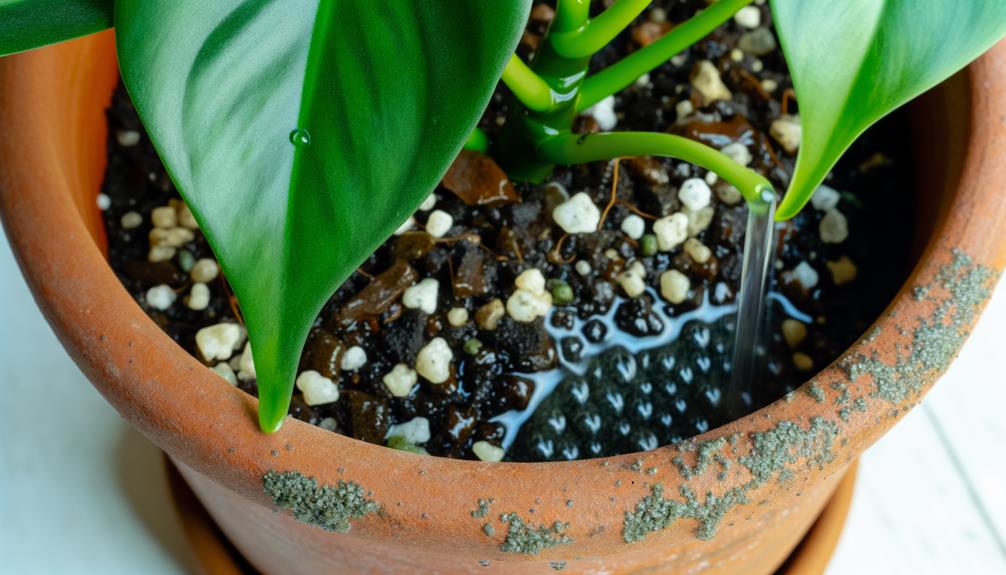
Proper drainage is necessary for Philodendron Cordatum to prevent waterlogged soil conditions, which can lead to root rot and other harmful health issues. Implementing a well-draining soil mix is vital. Consider the following:
- Perlite or pumice: These materials improve soil drainage by creating air pockets, allowing excess water to escape.
- Bark chips: Adding bark chips to the soil mix enhances drainage and mimics the plant's natural epiphytic environment.
- Drainage holes: Guarantee the pot has adequate drainage holes to facilitate water exit and prevent stagnation.
Aeration Benefits
In addition to promoting healthy root development, adequate soil aeration prevents compaction, thereby ensuring best nutrient and water uptake for Philodendron Cordatum.
Aerated soil facilitates oxygen flow to the roots, which is crucial for respiration and metabolic processes. This helps the roots to efficiently convert nutrients into energy, promoting vigorous growth.
Practical advice includes incorporating perlite or coarse sand into the soil mix to enhance its structure. These amendments create pore spaces that allow air to circulate, preventing the roots from becoming waterlogged.
Moreover, well-aerated soil mitigates the risk of root rot and other fungal infections, which thrive in oxygen-deprived conditions. Regularly checking and maintaining soil aeration is essential for sustaining the plant's long-term health.
Organic Matter
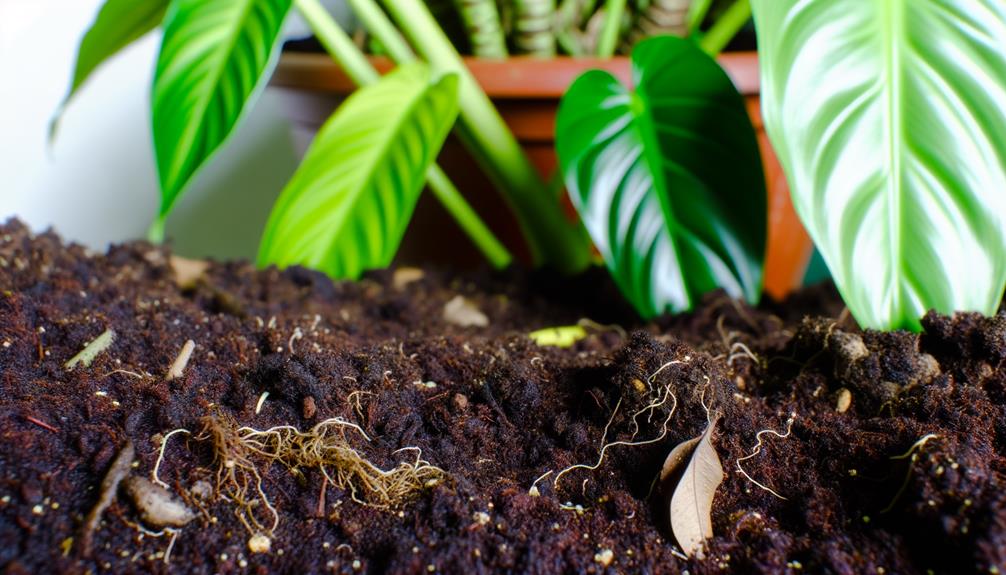
Incorporating organic matter into the soil composition for Philodendron Cordatum provides numerous agronomic benefits. It greatly enhances soil fertility by supplying essential nutrients, improves water retention capacity, and fosters beneficial microbial activity that supports root health.
Understanding and integrating these elements can optimize growth conditions for this species.
Enhances Soil Fertility
Enhancing soil fertility for a Philodendron Cordatum often involves the strategic addition of organic matter to improve nutrient availability and soil structure. Organic matter not only serves as a reservoir of essential nutrients but also enhances microbial activity, which in turn aids nutrient cycling.
Here are three key components that are crucial:
- Compost: Incorporating well-decomposed compost enriches the soil with macro and micronutrients, essential for plant growth.
- Worm Castings: These are rich in nitrogen, phosphorus, and potassium, and encourage beneficial microbial populations.
- Leaf Mold: This improves soil texture, providing a balanced environment for root development.
Boosts Water Retention
The inclusion of organic matter in the soil significantly enhances its water retention capacity, thereby providing a more stable moisture environment for Philodendron Cordatum.
Organic materials such as compost, peat moss, and coconut coir improve the soil's structure by increasing porosity and aggregation. This enhances the soil's ability to hold water without becoming waterlogged, ensuring a consistent supply of moisture to the plant roots.
For best results, integrate approximately 20-30% organic matter into the potting mix. Regularly monitor soil moisture levels to avoid overwatering, which can lead to root rot.
Employing a balanced blend of organic matter not only supports water retention but also contributes to a well-aerated, nutrient-rich medium, optimal for the healthy growth of Philodendron Cordatum.
Promotes Microbial Activity
One critical benefit of adding organic matter to the soil is the substantial promotion of microbial activity, which plays a pivotal role in nutrient cycling and soil health for Philodendron Cordatum. Microorganisms decompose organic matter, releasing essential nutrients in a plant-available form. This process enhances soil fertility and structure, leading to optimal plant growth.
To maximize microbial activity, consider the following:
- Incorporate Compost: Rich in organic material, compost fosters a thriving microbial community.
- Avoid Synthetic Fertilizers: These can disrupt beneficial microbes, inhibiting natural processes.
- Maintain Moisture Levels: Adequate hydration is necessary for microbial metabolism and activity.
Nutrient Needs
Understanding the nutrient needs of Philodendron cordatum is significant for best growth, focusing primarily on essential macronutrients such as nitrogen, phosphorus, and potassium.
Additionally, micronutrient requirements including iron, manganese, and zinc play a significant role in maintaining the plant's health.
Ensuring the soil pH remains within the 5.5 to 6.5 range is also crucial for nutrient availability and uptake.
Essential Macronutrients
Philodendron cordatum requires a balanced supply of essential macronutrients, specifically nitrogen (N), phosphorus (P), and potassium (K), to thrive effectively. These macronutrients play pivotal roles in plant health:
- Nitrogen (N): Essential for leaf growth and chlorophyll production, ensuring the plant maintains lush, green foliage.
- Phosphorus (P): Necessary for root development and energy transfer, promoting strong, healthy root systems and efficient nutrient uptake.
- Potassium (K): Essential for overall plant vigor, regulating water uptake, enzyme activation, and disease resistance.
For ideal growth, soil should have a nutrient-rich composition with a balanced N-P-K ratio, often found in well-formulated potting mixes or through regular fertilization. Ensuring the right macronutrient balance will lead to robust and vibrant Philodendron cordatum specimens.
Micronutrient Requirements
Sufficient micronutrient availability, including elements such as iron (Fe), manganese (Mn), and zinc (Zn), is important for the best physiological functioning of Philodendron cordatum. These micronutrients play vital roles in enzymatic activities, chlorophyll synthesis, and overall plant metabolism.
For instance, iron is essential for chlorophyll production and energy transfer within the plant. Manganese acts as a cofactor in various enzymatic reactions, while zinc is pivotal for protein synthesis and growth regulation.
To guarantee adequate micronutrient supply, incorporating a well-balanced, slow-release fertilizer or organic matter such as compost or worm castings into the soil mix is recommended. Regular monitoring of leaf color and growth patterns can help identify and correct potential deficiencies promptly.
Soil Ph Balance
Maintaining an ideal soil acidity level within the range of 5.5 to 6.5 is crucial for the nutrient absorption and overall health of Philodendron cordatum. This slightly acidic setting ensures the best availability of macronutrients such as nitrogen, phosphorus, and potassium, as well as essential micronutrients like iron, manganese, and zinc.
To achieve and sustain this acidity level, consider the following:
- Soil Testing: Regularly test soil acidity using a reliable kit to monitor fluctuations.
- Amendments: Apply organic material like peat moss or compost to lower acidity if necessary.
- Lime Application: Use agricultural lime to increase acidity if the soil is too basic.
Such careful acidity management promotes a flourishing environment, enabling vigorous growth and colorful foliage in Philodendron cordatum.
Moisture Retention
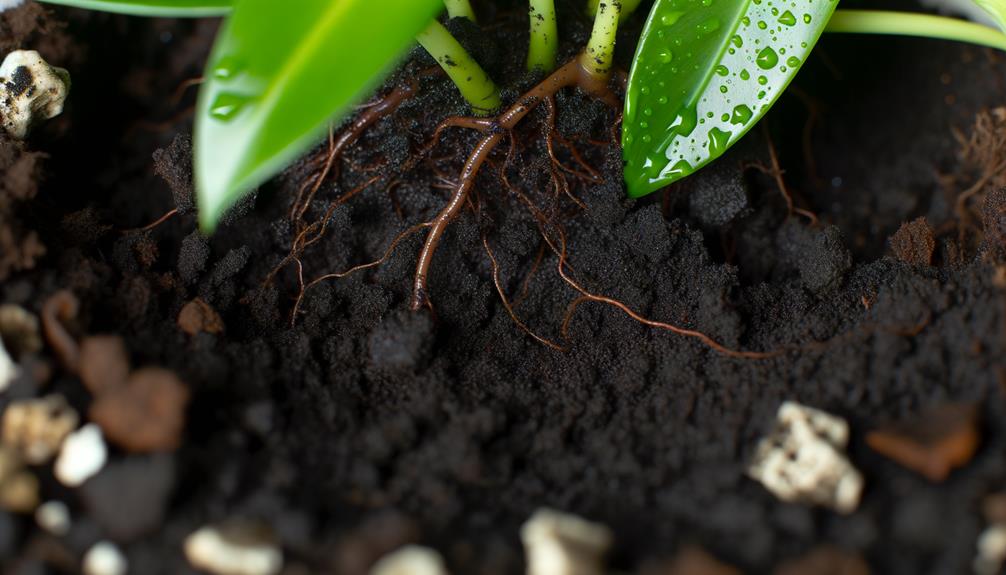
Effective moisture retention in the soil is crucial for guaranteeing the best growth and health of a Philodendron Cordatum.
The soil must balance sufficient water retention while allowing excess moisture to drain. An ideal medium typically includes organic components like peat moss or coconut coir, which help retain moisture without becoming waterlogged—essential in preventing root rot.
Additionally, perlite or coarse sand can be incorporated to enhance aeration and drainage. Monitoring soil moisture levels is also important; employing a moisture meter can provide precise readings to avoid overwatering.
Regularly checking the soil's moisture content and adjusting watering frequency accordingly will ensure a stable environment conducive to the Philodendron Cordatum's growth, promoting vigorous root development and lush foliage.
Common Soil Mixes
To achieve the ideal balance of moisture retention and drainage for a Philodendron Cordatum, several common soil mixes can be employed, each combining specific organic and inorganic components to enhance growing conditions.
- Peat-based Mix: Incorporates peat moss, which guarantees moisture retention, paired with perlite or sand for improved aeration and drainage.
- Coco Coir Blend: Utilizes coconut coir as a sustainable alternative to peat, mixed with orchid bark and perlite to enhance both moisture control and structural integrity.
- Commercial Aroid Mix: Pre-formulated for aroids, including Philodendron Cordatum, often containing a blend of peat, perlite, bark, and other organic matter to provide a balanced environment.
These mixtures are designed to support healthy root development and prevent waterlogging, hence ensuring the best plant growth.
DIY Soil Recipes
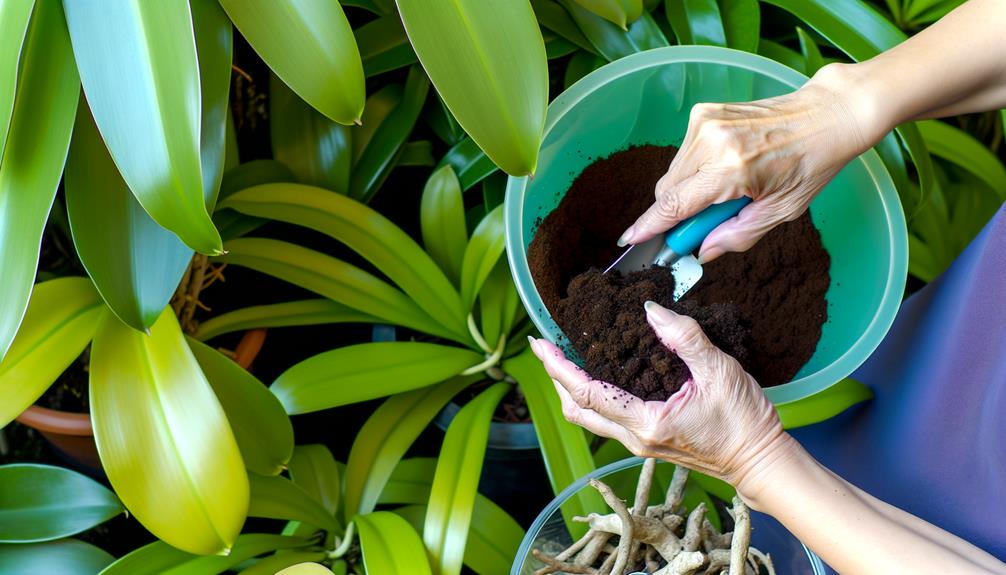
Creating a best DIY soil mix for Philodendron Cordatum involves understanding the basic soil components such as peat, perlite, and compost.
Effective mixing techniques guarantee these elements are combined to provide sufficient aeration, moisture retention, and nutrient availability.
Basic Soil Components
When assembling the most suitable soil mix for a Philodendron Cordatum, it is important to understand the fundamental components that guarantee proper aeration, moisture retention, and nutrient availability. These components typically include:
- Peat Moss: This organic matter improves moisture retention while preventing soil compaction, which is essential for root health.
- Perlite: A volcanic mineral that enhances aeration, ensuring oxygen reaches the roots and facilitating proper drainage to prevent root rot.
- Compost: Rich in essential nutrients, compost provides a steady supply of organic matter that supports sustained plant growth.
Each of these components plays a critical role in creating an ideal growing environment. By combining them in appropriate proportions, one can craft a well-balanced soil mix tailored to the specific needs of Philodendron Cordatum.
Mixing Techniques
Understanding the fundamental soil components sets the foundation for discussing effective mixing techniques that secure the Philodendron Cordatum thrives in a DIY soil recipe.
Start by blending equal parts of peat moss and perlite for an ideal aeration and moisture retention. Incorporate a third component, orchid bark, to enhance drainage and mimic the plant's natural epiphytic environment. A 1:1:1 ratio secures a balanced mix, promoting root health and preventing waterlogging.
To further enrich the medium, consider adding a small portion of worm castings for essential nutrients. Thoroughly mix these ingredients in a large container to secure uniform distribution.
This tailored soil blend supports the Philodendron Cordatum's growth by providing the necessary balance of aeration, drainage, and nutrient availability.
Soil Maintenance Tips
Regularly evaluating the soil's moisture levels and nutrient content is vital to maintaining ideal conditions for a Philodendron Cordatum. Consistent monitoring prevents root rot and nutrient deficiencies, promoting robust growth.
Implement the following maintenance tips:
- Moisture Check: Utilize a digital moisture meter to measure soil moisture weekly. Guarantee the soil remains slightly damp but not waterlogged.
- Nutrient Balance: Conduct soil tests bi-annually to assess nutrient levels. Amend with a well-balanced liquid fertilizer, diluted to half strength, every 4-6 weeks during the growing season.
- Aeration: Periodically aerate the soil by gently loosening it with a small fork. This enhances oxygen flow to the roots, preventing compaction and promoting healthy development.
These practices ensure peak soil conditions, fostering a thriving Philodendron Cordatum.
Conclusion
To sum up, choosing the best soil for Philodendron cordatum is crucial for its well-being and development. A well-draining blend with a pH between 5.5 and 6.5, enriched with organic material, guarantees proper moisture retention and aeration.
Routine soil care can greatly boost plant health. Notably, research has revealed that soils with more than 40% organic content can enhance root growth by up to 60%, highlighting the significance of a nutrient-rich base for this plant.






